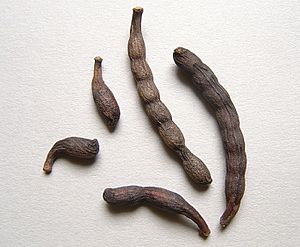Xylopia aethiopica facts for kids
Quick facts for kids Xylopia aethiopica |
|
|---|---|
 |
|
| Ethiopian-pepper | |
| Scientific classification | |
| Genus: |
Xylopia
|
| Species: |
aethiopica
|
Xylopia aethiopica, also known as the Ethiopian pepper or grains of Selim, is a tall, evergreen tree. It belongs to the Annonaceae family and can grow up to 20 meters (about 65 feet) high. This amazing tree naturally grows in the lowland rainforests and moist forest edges of Africa's savanna regions.
People use the dried fruits of the Xylopia aethiopica tree as a popular spice and also in herbal medicine.
Contents
What's in a Name?
The name Xylopia comes from two ancient Greek words: xylon and pikron. Together, they mean "bitter wood," which describes a quality of the tree's wood. The second part of its scientific name, aethiopica, tells us that the tree was first linked to Ethiopia. Even though it's named after Ethiopia, today you'll find it growing mostly as a crop in countries like Ghana, Togo, and other parts of West Africa.
Where Does It Grow?
The Xylopia aethiopica tree grows across many parts of tropical Africa. You can find it in rainforests, especially close to the coast. It also thrives near rivers and in forests along the edges of other land types. This tree is also a "pioneer species," meaning it's one of the first plants to grow in dry savanna areas.
This tree is found in many African countries, including:
How People Use This Tree
The Xylopia aethiopica tree is very useful! People use it for building, in African cuisine, and in traditional medicine.
Building with Xylopia Wood
The strong wood from the Xylopia aethiopica tree is great for construction. People use its bark to make doors and room dividers. The wood itself is known to be tough and resists termites, which are tiny insects that can damage wood. Because of this, it's used to build huts, including posts, roof supports, and floor beams. The wood is also used to build boats, making parts like masts, oars, and paddles. Long ago, in Togo and Gabon, people even used this wood to make bows and crossbows for hunting and fighting.
Xylopia in Traditional Medicine
Many parts of the Xylopia aethiopica tree are used in traditional healing. For example, a special liquid made from the tree's bark or fruit can help treat bronchitis (a chest cold) and stomach problems. It can also be used as a mouthwash to help with toothaches. The bark, when soaked in palm wine, is used to treat asthma, stomach pains, and rheumatism (joint pain).
Xylopia in Food and Drink
The fruit of the Xylopia aethiopica tree is a popular spice. In Senegal, the fruit is used to flavor a special coffee drink called café Touba. This drink is very important to the Mouride brotherhood in the country. A long time ago, in the Middle Ages, the fruit was even sent to Europe and sold as a type of 'pepper.'
In eastern Nigeria, the fruit is a key ingredient in local soups. These soups are often given to new mothers to help them with breastfeeding. Across Africa, the fruit is still an important item for local trade, used as a spice, a food flavoring, and for medicine. Sometimes, the fruit is even put into jars of water to help purify the water.
See also
 In Spanish: Xylopia aethiopica para niños
In Spanish: Xylopia aethiopica para niños

